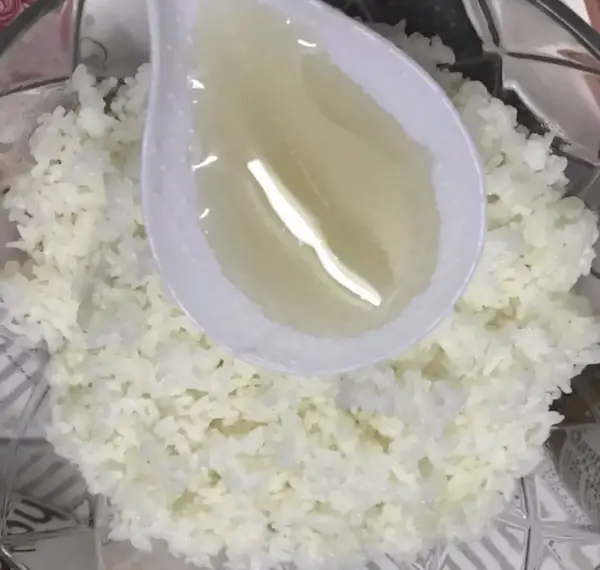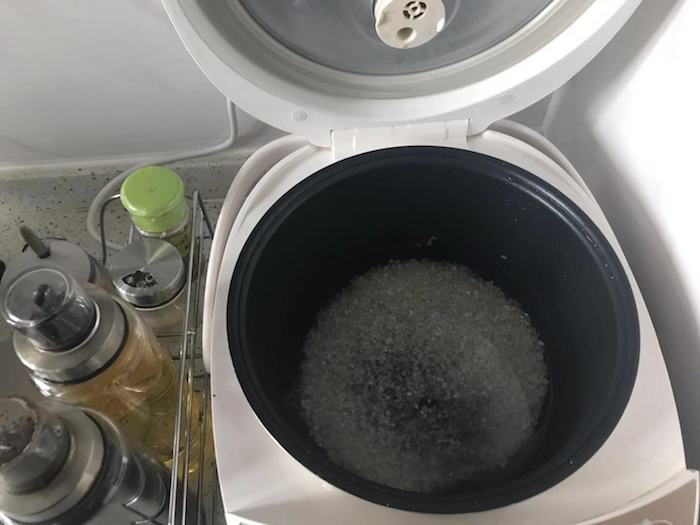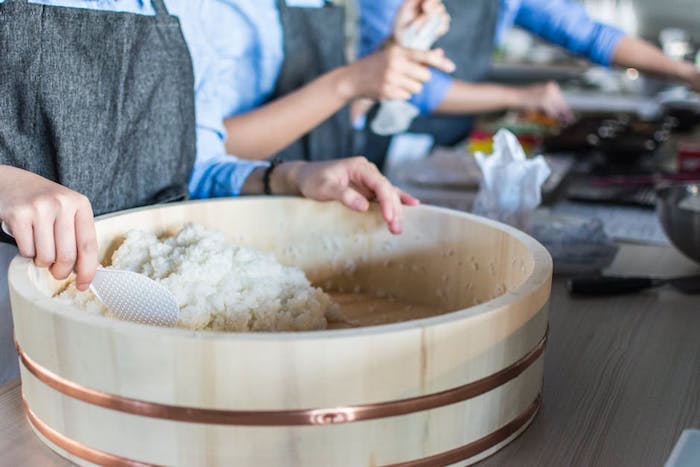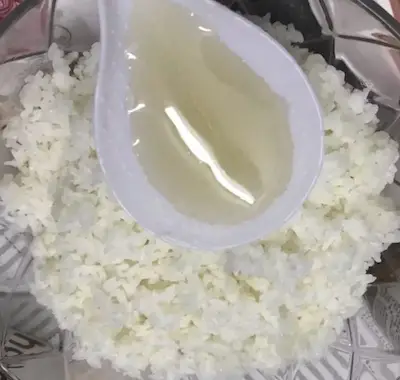We are reader supported. When you purchase through links on our site, we may earn an affiliate commission. Also, as an Amazon affiliate, we earn from qualifying purchases.

I know most people think of raw fish, seafood, and veggies when they hear sushi but believe me, sushi rice is an important component of this delicacy. It forms the base that holds the other ingredients together and gives sushi that characteristic taste. However, preparing sushi rice takes time because it does not just involve cooking rice but also seasoning with vinegar, sugar, and salt.
Sushi enthusiasts and home cooks often ask me ‘can you make sushi rice ahead of time?’ and my answer is yes, why not, but make sure it is stored properly. You can make sushi rice up to 5-6 hours in advance of your dinner time. However, please bear in mind that this depends on a lot of variable factors such as outside temperature, humidity levels, etc.
If it’s too hot and humid, sushi rice can go bad after sitting outside for 2 hours and when left out at room temperature beyond that, it may be subject to getting spoiled due to bacterial contamination, unless all the variable and acidity levels are carefully checked.
Contents
Benefits Of Making Sushi Rice Ahead Of Time
If you prepare sushi rice ahead of time, think about the amount of time you can save during dinner. So, if you have guests coming over, you can relax instead of slogging in the kitchen and being worried about the sushi rice coming out perfectly, not uncooked or soggy.
When you have cooked and cooled sushi rice beforehand, all you need to do is slice the raw fish or chop the veggies and put everything together. You will also not burn your hands trying to grab a ball of rice to spread it over the nori sheet.
Many restaurants make sushi rice ahead of time so that they don’t fall short of ingredients when there’s a sudden influx of customers. Sushi rice gets consumed at a faster rate in restaurants, so there’s not much risk associated. Furthermore, they are also required to follow the HACCP (Hazard Analysis and Critical Control Point)requirements to ensure that the rice does not cause illness.
Refrigerating sushi rice after it gets to room temperature may save it from going bad but it’s not the ideal option because freezing will harden the texture of rice. This will make it unsuitable for achieving the perfect form of sushi in nigiri or makizushi styles.
Health Risk Associated With Rice Made Ahead Of Time
Sometimes, the uncooked rice may contain spores that survive the intense heat when rice is cooked. If the rice sits for too long at room temperature, these spores turn into bacteria that cause food poisoning. Although the sushi takeout options when you are extremely hungry are one of life’s great pleasures, the sushi rice may be bad for you if left out at room temperature for too long.
If you made sushi rice in the morning and left it outside until dinner time at night, chances are that rice will be contaminated with bacteria. Even if it smells and tastes perfectly normal, there may be Bacillus cereus not visible to the naked eye. When in confusion, I would always suggest you toss the rice out of the window without thinking twice.
While you can save the rice cooked in the morning by refrigerating it immediately after it gets to room temperature, you will need to compromise with the texture. Sushi rice stored in refrigerator tends to get dehydrated and bland. Reheating in the microwave for about 30 seconds may help restore the texture and make slightly fluffy but it can’t restore the original texture.
Invest In A Good Rice Cooker

If cooking sushi rice in a pot seems like a lot of work or you lack the skills, I would suggest that you invest in a good quality rice cooker (see my reviews). This will save you from the time-consuming process that intimidates most sushi home cooks.
With an electric cooker, you can have the rice ready in minutes and you don’t need any skills to do that. Just add water and rice as instructed – and you are done! Some rice cookers come with umami settings to ensure that the quality impresses even the most discerning sushi traditionalists.
To cool the sushi rice quickly, spread it on a flat bottomed vessel and use a hand-operated fan to quickly bring it down to room temperature. You can also switch on the ceiling fans or put the air conditioner on full blast to speed-up cooling.
I have created an article that talks about the best rice cookers you can buy under $200. If you don’t eat rice that often, a low-cost cooker may be fine. However, if you like cooking sushi frequently, look for models with extra features. Read my unbiased reviews to take the stress out of buying the best rice cooker for your needs.
Ways To Store Sushi Rice In Refrigerator
Sushi rice is meant to be used immediately after it’s cooked and seasoned. However, if for any reason, you make sushi rice ahead of time, it is important to store it properly. Here are some of the best ways to store sushi rice inside the refrigerator without causing it to dehydrate or lose flavor.
# Refrigerate In A Zip Lock Bag Or Air-Tight Container
After the rice is cooked properly, let it sit until it is not hot anymore. This is important to ensure that moisture does not get trapped in the rice as this could lead to bacterial growth. While it’s still warm, season the sushi rice with vinegar, sugar, and salt to enhance the flavor and increase its shelf life.
When the rice is about 5 degrees centigrade, you can now safely store it inside the refrigerator. Take a damp towel and cover the rice with it in order to prevent dehydration. Keep the wrapped sushi rice in an airtight container or zip lock bag, and now store in the refrigerator.
The sushi rice can stay good for up to three days, however, please bear in mind that the flavor and texture may not be the same. You may use the cold rice or heat it for a few seconds in the microwave before using in making sushi.
Reheating several times can spoil refrigerated sushi rice, hence I would suggest that you warm it once or use as it is. The grocery store sushi are kept in the cold section and it tastes fine, so cold sushi rice (if not hardened or dehydrated) should not be an issue.
# Freeze In Japanese Containers With Steam Vent
Alternatively, you may buy the Japanese plastic or glass containers that can be found in any Asian grocery store. These microwavable bowls have steam vents and they are specially designed for freezing and heating rice. They come handy for households where rice is a staple food. If you like eating sushi almost every day but don’t enjoy cooking rice every time, this is a must-have for you!
The best way of storing rice in these containers is to pack the rice while it’s still steaming hot so that some of the moisture gets locked inside the container. You can now keep it in the freezer and the rice will stay good for up to one month.
When you want to use the sushi rice, just take it out of the freezer, open the ventilation lid and microwave for 2-3 minutes. If you bought a large container, you may need to heat for 3-4 minutes to defrost the rice completely.
5 Signs That Tell Sushi Rice Has Gone Bad

I am sure you are happy to discover the answer for ‘can you make sushi rice ahead for time’ but please bear in mind that anything that is not fresh has a chance of going bad. Whether the rice was out at room temperature for just 2 hours or you had properly stored the rice in a zip lock bag, there’s still a possibility that the rice may go bad. Here are some of the signs that indicate sushi rice has gone bad.
- Smell the rice after you take it out of the airtight container or bag. Does it give a bad whiff that makes you want to puke? Chances are the rice has gone bad.
- If you refrigerated the rice in a hurry without covering it in a damp towel or storing in a zip-lock bag, the rice will harden and taste bland. You may use it to make fried rice but it’s not suitable for sushi.
- Do you see signs of perspiration over sushi rice? This indicates that it has entered the stage of spoilage. Hence, it must be discarded.
- Sushi rice should look pearly white in color. If you see yellowish stains or any form of discoloration, the sushi rice has gone bad.
- If the rice has been cooled, heated, and then refrigerated again, it has possibly turned into a playground for bacteria that you can’t see without a microscope, so throw it away.
Related Questions
What is the best type of rice used for making sushi?
I strongly suggest buying Japanese short-grain rice (shinmai variety) because it has a sticky texture that enables the rice to stay together while forming nigiri or sushi rolls. It also has a nice flavor that gives this Japanese delicacy a unique taste.
Can uncooked rice go bad?
Uncooked white sushi rice typically has a longer shelf life. The sealed bags can last indefinitely and the opened bags can be safely stored in a refrigerator or freezer for long. However, they may often go bad due to contamination, dust, or moisture. I have created an article that talks at length about does uncooked rice go bad.
Can I use leftover sushi rice the next day?
Yes, if you made extra sushi rice than needed, wrap it in a damp towel, keep in an air-tight container and stash away in the refrigerator. Next morning you can microwave it for 30 seconds and make a chirashi bowl with leftover ingredients.
For more information: How To Use Leftover Sushi Rice (Besides Making Sushi)?
How long can sushi rice stay in the refrigerator?
You can store cooked sushi rice successfully in a refrigerator for 4-6 days if kept inside a resealable bag. However, I would recommend that you make a small batch of sushi rice in cooker instead of using old and frozen rice.
See Also: Can You Freeze Sushi?

